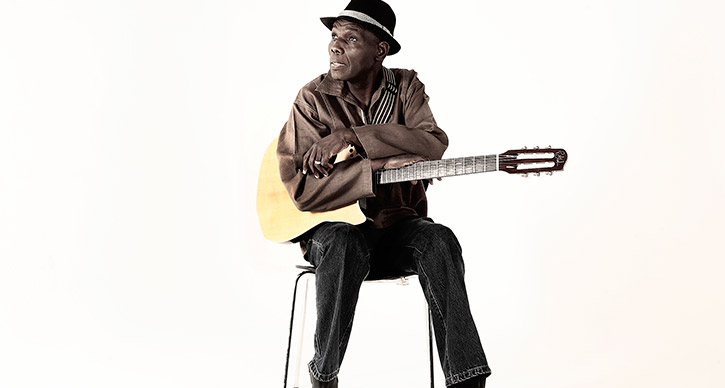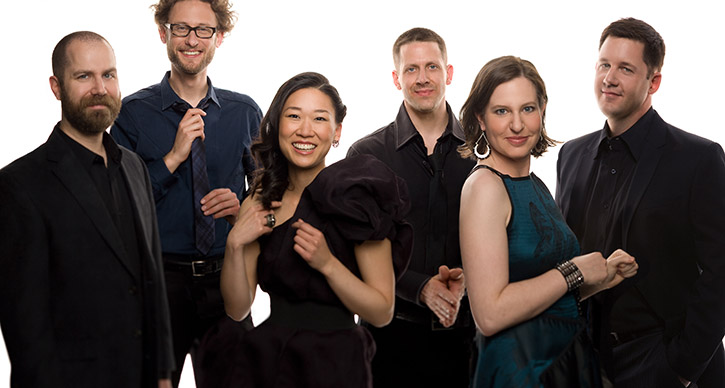Study Up: Brief History of Robots in Film
 Photo: Nufonia Must Fall, on stage. By Jorn Mulder.
Photo: Nufonia Must Fall, on stage. By Jorn Mulder.
DJ Kid Koala’s graphic novel Nufonia Must Fall is about a headphones-sporting robot on the verge of obsolescence who falls in love with a lonely office girl. On March 11-12, 2016, the live adaptation of this novel comes to Power Center. The show will feature real-time filming of more than a dozen miniature stages and a cast of puppets, while Kid Koala and the Cecilia Quartet provide original live scoring on piano, strings, and turntables.
This won’t be the first time a robot appears on the film screen. We present to you, a brief history of robots in film.
1930-1940
The Wizard of Oz (1939) introduced the Tin Man, one of film’s most recognizable robots. While the Tin Man is lovable and human-like, the 30’s and 40’s still frequently included narratives of mad scientists and uncontrollable killer robots.
1950-1960
Film robots of the 1950’s reflected fear of the new forms of violence made possible by technology during the Cold War. The Day the Earth Stood Still (1951) depicts Gort, an enormous, metal, alien robot who delivers an anti-nuclear message to Earth. Stanley Kubrick’s 2001: A Space Odyssey (1968) features HAL, one of film’s most recognizable robots. HAL is a computer, not a traditional corporeal robot, and the film predicts robots with advanced speech comprehension and processing abilities.
1970-1980
Star Wars set the standard for robots on film in the 1970’s and 80’s. C-3PO and R2-D2, two of the series’ most lovable and iconic characters, are motivated by human emotions and experiences. But the period also produced many evil robots, notably the Terminator franchise, which portrays wars between humans and robots.
1990-2000 and beyond
Robots in the movies at the turn of the 21st century affirm the increasing affection for technology of the time. WALL-E (2004) reverses the trope of robot domination when a pair of robots saves the earth for humanity.
For additional information about the history of robots in cinema visit this website.
Excerpted from UMS Learning Guide about Nufonia Must Fall.
Nufonia Must Fall is at Power Center in Ann Arbor March 11-12, 2016.
Study Up: Tanya Tagaq Teaches You to Throat Sing
 Photo: Tanya Tagaq. By Ivan Otis.
Photo: Tanya Tagaq. By Ivan Otis.
“Nobody, anywhere, sounds like she does,” said the Globe and Mail of Tanya Tagaq, who performs at the Lydia Mendelssohn Theatre on February 2, 2016.
Tagaq has received many awards, but one of our favorites is Rolling Stone magazine’s “Best Scream” award for her performance at Bonnaroo festival. Her Ann Arbor performance features the Inuit throat singer accompanying a screening of Nanook of the North (1922) with a live score.
How to throat sing
Throat singers produce more than one pitch at a time through the positioning of the lips, tongue, larynx, and jaw. Though unfamiliar to most Western ears, throat singing is part of a number of global musical traditions including those of central Asia, South Africa,
and northern Canada. Inuit throat singing originated as a way for women to entertain themselves and engage in friendly competition while men were away hunting. Two women face one another closely and improvise musical patterns; the first one to laugh or run out of breath loses.
Watch this video to learn more about Inuit throat singing in its traditional form:
In this video, Tanya Tagaq explains the vocal processes used to create the basic sonic building blocks of Inuit throat singing. She usually tells her students to “spend one year trying to sound like their dog.”
Videos excerpted from UMS Learning Guide for Tanya Tagaq.
Tanya Tagaq performs at the Lydia Mendelssohn Theatre on February 2, 2016.
UMS Playlist: Social Change and African Popular Music
This post is a part of a series of playlists curated by UMS staff, artists, and community. Check out more music here.

Oliver Mtukudzi. Photo courtesy of the artist.
Zimbabwe’s Afropop legend Oliver Mtukudzi performs in Ann Arbor on April 17, 2015.
“Tuku” has created 61 solo albums to date, many of which focus on political and social themes. His band The Black Spirits got its start performing songs protesting the white colonial rule of Zimbabwe in the 1960s and 70s.
Throughout his career, Tuku has refrained from direct political criticism, instead using metaphor to communicate his ideas: “The beauty of the Shona language is that it is endowed with all those rich idioms and metaphor…and the beauty of art is that you can use the power of language to craft particular meaning without necessarily giving it away. So, I used the beauty of Shona to communicate in my own way and people got the message.”
Themes of social change are common in popular African music. In this listening guide, explore some of the history of this connection.
1. Nelson Mandela commissioned the group “Sipho Hotstix Mabuse” to write a campaign theme song for his bid to be South Africa’s first democratically elected president in 1994. Simply titled “Nelson Mandela,” the song speaks frankly about the Mandela’s hopes to promote unity in the country.
2. Angelique Kidjo (who last performed in Ann Arbor in 2013) blends musical traditions from her native Benin with Western popular music, singing in English as well as her childhood languages of Fon and Yoruba. Many of her songs include themes of peace, tolerance, and liberation. In “Kulumbu,” Kidjo speaks about the nececsity for women to participate in conflict resolution after suffering disproportionately during war.
3. The title of Bassekou Kouyate’s song “Jama Ko” translates to “the gathering,” and urges for peace and reconciliation in Mali. Bassekou Kouyate last performed in Ann Arbor as part of our 2013-2014 season.
4. Tuku’s song “Wasakara” describes the corruption and violence of the government of Zimbabwean president Robert Mugabe. He sings, “Admit it, you are wrinkled/You are worn out.”
5. Thomas Mampfuno also criticizes the government in “Mamvemve,” with the lyrics “the country you used to cry for is now in tatters.” Zimbabwe’s political environment is so restrictive that Mampfuno has not visited the country since 2004.
6. In “Ndakuvara,” Mugabe is represented by an ox too stubborn to learn from its elders. Through metaphor, Tuku writes protest as subtext subtle enough to allow him to remain in Zimbabwe.
What did you think about this playlist? What songs would you add?
UMS Playlist: Evolution of Chamber Music
This post is a part of a series of playlists curated by UMS staff, artists, and community. Check out more music here.

eigth blackbird. Photo by Luke Ratray.
The Chicago-based chamber ensemble eighth blackbird performs in Ann Arbor on January 17. eighth blackbird is on the new frontier of contemporary music. As Los Angeles Times explains, “the blackbirds are examples of a new breed of super-musicians. They perform the bulk of their new music from memory. They have no need for a conductor, no matter how complex the rhythms or balances… [They are] stage animals, often in motion, enacting their scores as they play them.”
How did chamber music, which originated in the Middle Ages, evolve into the music of the blackbirds? Explore the history with our listening guide:
1. Chamber music originated during the Middle Ages as a form of entertainment for guests in palace chambers. “Mille Regretz” by Josquin des Prez (1450-1521) is an example of the style and structure of sacred music translated to a secular song that describes the pain of a lost love. The earliest chamber music often also included lutes, recorders, and early versions of the violin, viola, and cello.
2. The string quartet, one of the most common chamber ensembles, developed into its current form in the early 17th century. Since then, composers from Haydn to Beethoven to Shostakovich have revered the string quartet’s form because of the challenge of writing four unique parts that constantly change and interact with one another. The string quartet includes two violins, viola, and cello. In this track, listen for Beethoven’s mastery of “counterpoint,” the relationships between the voices.
3. Chamber music in the 20th century brought together new instrument groupings. The brass (featuring two trumpets, trombone, French horn, trombone, and tuba) rose in popularity in the 1940s. Victor Ewald is widely considered to the first composer of brass quintet music.
4. Chamber music concepts extend across genre; though “chamber music” is primarily used to describe classical music, the John Coltrane Quartet exemplifies excellent chamber music playing.
5. eighth blackbird illustrates the vast range of 21st century chamber ensembles. On this track, the group performs Steve Reich’s minimalist composition “Fast: 8:39.”
6. eighth blackbird showcases its virtuosic ensemble connectivity with Thomas Adés’ rhythmically complex “Catch.”
7. eighth blackbird collaborates with electronic music composer Dennis Desantis on the track “strange imaginary remix.”
What did you think about this playlist? Share your thoughts or song suggestions in the comments below.


